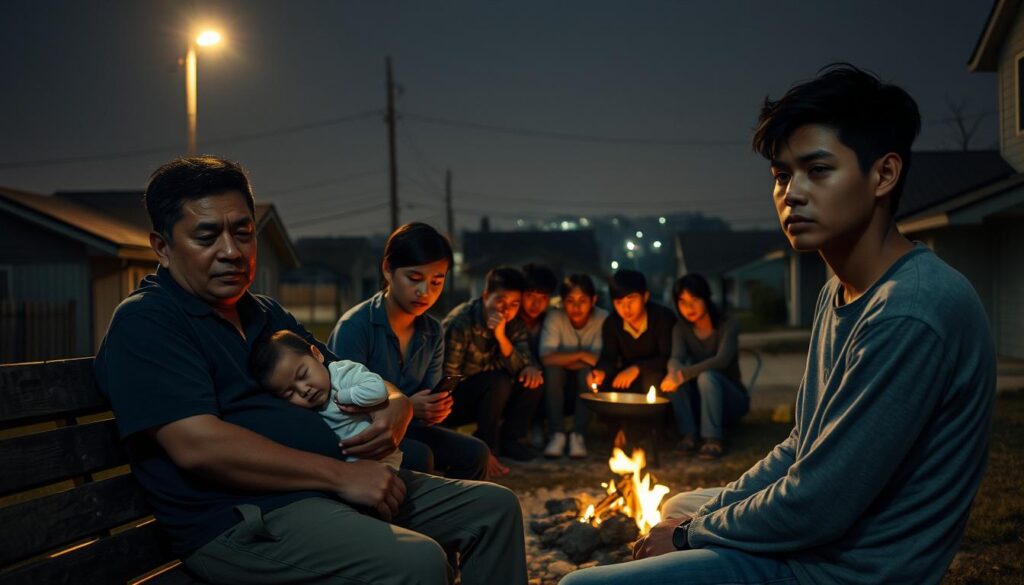Do you only associate homelessness with big cities? What if suburban homelessness is growing into a crisis in forgotten suburbs? This situation is changing people’s views about where homelessness occurs and questioning the strength of our communities.
In the entire United States, the story is shifting. Both suburban and rural places are now facing a homelessness challenge. It’s moving beyond the cities. This issue is making people and those in power rethink how to help. They’re looking at new ways to solve this growing problem.
In quiet suburbs and rural places, there is a struggle for survival happening every day. It’s bringing to light the need to rethink how we support and view these people. Recognizing and tackling this crisis is key to finding solutions that involve the whole community.
The Hidden Crisis: Suburban Homelessness
Suburban poverty is on the rise, but it often stays hidden. Unlike cities, you don’t see homelessness as much in the suburban areas. Families there struggle with finding stable places to live. They might stay in in shelters, temporary shelters shelters, motels, or with friends and family. Because it’s not as visible, suburban homelessness doesn’t get the attention it needs.
The resources in suburbs don’t match what’s found in cities. Suburban communities often have less support for those in need. Even if there is some help available, it’s not enough and covers too much area. For example, in places like Brookline, Massachusetts, and Greenville, South Carolina, poverty is rising but help is scarce.
The data shows how big the gap is between urban and suburban support. Here’s a table to show the difference:
| Region | Population | Homeless Shelters | Social Services Access |
|---|---|---|---|
| Suburban Areas | 10 million | 50 | Limited |
| Urban Areas | 10 million | 150 | Extensive |
Fighting suburban poverty needs more attention. We must raise awareness and build better local support. By understanding the unique problems faced in suburban communities, we can come up with specific solutions. This will help people in need find stable homes.
A Look at Rural Homelessness
In rural America, homelessness can be hard to see. The population is spread out, making the issue less visible. Unlike cities, where homeless people are easier to spot, rural homelessness often stays hidden. This makes it tough for those trying to help, as they can’t see the full extent of the problem.
Poverty in rural places is a big issue. There aren’t many jobs that pay well, and resources are limited. People live with the fear of losing their homes, and when they do, there’s not much help available. The lack of shelters and support makes it even harder for them.
It’s also difficult to get accurate information on rural homelessness. Good data is rare, which makes understanding the issue tough. Without solid numbers, coming up with strategies to help is challenging.
To help those facing homelessness in rural areas, fresh ideas and teamwork are needed. Community groups, leaders, and locals must join forces. By fighting poverty and creating strong support systems, we can ensure no one is forgotten.
Living Conditions in Forgotten Suburbs: Camps and Car Living
Many people without homes live in rough camps or in cars. They do this because there is no other housing available for them. These conditions are often tough, with no easy access to basic needs.
Life in homeless camps is hard. There’s no clean water, good shelter, or safety. Even so, some find it better than living in a car. Others turn their cars into homes. This choice comes with its own set of problems like finding a safe place to park and legal issues. Cars offer more safety than tents but still lack what’s needed for a proper life.
Temporary shelters are too full and can’t help everyone. This leaves many people with nowhere to go but these camps or their cars. A lot of people can’t find affordable places to live. This makes more people live in camps or cars. To really help, we need big changes and more support for those without homes.

The Role of Addiction and Mental Health
Understanding the connection between addiction, mental health, and suburban homelessness is key. Many who are homeless in suburbs struggle with these issues, sometimes both. The global impact of mental disorders is growing, especially among young adults at their peak productivity. This problem hits harder in developing countries, facing a huge rise in mental health issues soon.
Dementia and major depression rank high in causing disability. Urban women often face more anxiety and depression, making life even harder for them. The mix of high drug use, domestic violence, and alcoholism adds to the problem. Poor access to healthcare and health support services makes things worse.
The growing need for mental health and addiction recovery support is clear. In cities, where up to 80.6% may have mental disorders, good services can really help. Yet, suburbs often lack these important resources, leaving many without needed support. Filling these service gaps could greatly help reduce homelessness in suburbs and boost many lives.
Economic Factors Contributing to Suburban Homelessness
Suburban areas are facing tough times with more people becoming homeless. This problem used to be mainly in big cities. A big cause is economic instability. It affects whole communities, pushing many towards homelessness.
Unemployment makes things worse. Losing jobs in struggling suburbs can quickly lead to less money for families. This often means they can’t keep up their way of living, possibly losing their homes.
Housing costs are another big issue. As prices for homes and rent go up, many people can’t afford to live in their own neighborhoods. Even those with jobs may not be able to find affordable homes. This shows how urgent it is to deal with this problem.
Together, economic instability, rising unemployment, and lack of affordable housing create a serious situation. These issues force many suburban families into tough spots. Solving these problems requires working together, so we don’t ignore suburban areas when tackling homelessness.
The Support Systems: Churches and Non-Profits
Religious organizations and non-profits are key in helping those without homes in less urban areas. They offer help where government support may be lacking. Essential services they provide are often the difference between survival and despair for many.
Churches have always been major players in supporting communities. They not just give shelter and food, but also long-term housing help. They also offer spiritual care, making people feel part of a community.
Non-profits play a big role too. They don’t just help with housing. They also provide job training, medical care, and mental health services. Their focus and flexibility let them meet the homeless’s needs fast.
When churches and non-profits work together, they do even better. They combine their strengths to support homeless people in more ways. This teamwork means people get both immediate help and aid for the future.
To sum it up, the work of these groups is really important. They keep providing key services and support to homeless folks in suburbs and countryside. Their efforts show why community action is crucial in dealing with homelessness.
Federal and State Response to the Crisis
The federal and state response to homelessness has been wide-ranging, yet faced hurdles. Recent efforts by the governments focus on upping funds for homelessness, aiming to boost permanent housing solutions. Still, how these policies unfold can differ by state, resulting in uneven results.

The Continuum of Care (CoC) program, run by the Department of Housing and Urban Development (HUD), is showing progress. It helps local areas by giving them grants, encouraging teamwork the public sector, non-profits, and government agencies. But, how well these projects work depends largely on local leaders and their community-specific approaches.
State-led funding efforts are also key. For example, California’s Project Roomkey offers temporary shelters and help for the homeless, showing a route forward. Yet, these steps often don’t reach a lasting solution.
In the end, although policies and funds for homelessness are improving, a gap remains in achieving consistent, flexible public sector solutions. For a real change in tackling homelessness across the U.S., policies must be applied evenly and reviewed often.
Solutions and Innovative Approaches
Solving homelessness needs many strategies, like sustainable answers, innovative homes, and community projects. Across the United States, new methods are helping people find stable and affordable places to live.
One popular idea is making tiny home villages. These villages give a safe, affordable, and eco-friendly place for people without homes. Tiny homes also help the environment and are a long-lasting answer for homelessness.
Rent control is another way cities are fighting homelessness. It keeps rent prices stable, so more people can afford their homes. This reduces the number of people becoming homeless.
Improving mental health services is key to tackle homelessness’s root causes. Many programs include mental health and addiction services. With the right support, people are more likely to get back on their feet.
| Location | Solution | Impact |
|---|---|---|
| Seattle, WA | Tiny Home Villages | Reduced unsheltered homeless by 20% |
| New York, NY | Rent Control | Increased housing stability |
| Los Angeles, CA | Mental Health Services | Improved mental health outcomes |
Community initiatives are also key in stopping homelessness. They connect people in need with services. Local groups and non-profits offer specific solutions that large organizations might miss. This makes the fight against homelessness stronger.
How You Can Make a Difference with Lifeway Programs
Helping your community starts with you participating in Lifeway programs. These programs aim to help people without homes become part of the community again. By joining in, you help make lives better, both for individuals and the community as a whole.
Lifeway programs cover important areas to offer complete support:
- Providing temporary housing solutions
- Offering mental health and addiction support
- Facilitating job training and placement services
- Encouraging community engagement activities
Your help as a volunteer is crucial for these programs to succeed. Whether it’s your time, skills, or money, you make a big difference in building a supportive community. Here’s how you can get involved:
| Involvement Type | Description |
|---|---|
| Volunteer | Help out directly by mentoring, offering training, or at events. |
| Donate | Give money to support Lifeway’s housing, health, and education projects. |
| Advocate | Help people understand the problem of homelessness and push for change. |
Joining Lifeway Programs lets you create a strong, caring community. Your involvement sparks change, breaks the cycle of homelessness, and gives hope to many.
Conclusion
We’ve learned a lot about suburban homelessness, noticing some key points. This problem often gets unnoticed but is pretty big. Many people live in tough situations, like in camps or their cars. Their stories show us why we need good support for addiction and mental health.
It’s clear we need everyone – churches, nonprofits, and the government – to work together.


